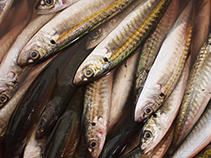| Family: |
Carangidae (Jacks and pompanos), subfamily: Caranginae |
| Max. size: |
30 cm SL (male/unsexed); max.weight: 300.0 g |
| Environment: |
reef-associated; marine; depth range 0 - 100 m |
| Distribution: |
Western Atlantic: Nova Scotia, Canada (Ref. 7251) southward through the Gulf of Mexico and the Caribbean to Rio de Janeiro, Brazil. Eastern Atlantic: Morocco to South Africa, including the Madeira, Canary, Cape Verde, Ascension and St. Helena islands (Ref. 7097). |
| Diagnosis: |
Dorsal spines (total): 9-9; Dorsal soft rays (total): 30-34; Anal spines: 3-3; Anal soft rays: 26-29. Greenish above, whitish below; adults with 3-1 small black spots on curved LL; opercle with small black spot (Ref. 3197). |
| Biology: |
Adults inhabit neritic waters, often near sandy beaches (Ref. 5217). A shoaling species, generally near the bottom (Ref. 27121). They feed on planktonic invertebrates, primarily copepods, but also on gastropod larvae, ostracods and pteropods (Ref. 3277). Spawning occurs well offshore year-round (Ref. 26938). Eggs are pelagic (Ref. 4233). A good food fish (Ref. 9626). Caught commercially and used mainly for bait. |
| IUCN Red List Status: |
Least Concern (LC); Date assessed: 20 August 2012 Ref. (130435)
|
| Threat to humans: |
harmless |
Source and more info: www.fishbase.org. For personal, classroom, and other internal use only. Not for publication.
